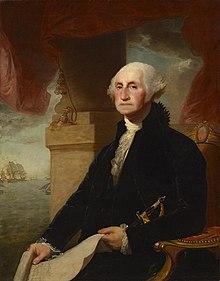Declaration of Independence[edit]
On July 2, 1776, the Second Continental Congress, meeting in Philadelphia, declared the independence of the colonies by adopting the resolution from Richard Henry Lee, that stated:
On July 4, 1776 they adopted the Declaration of Independence and this date is celebrated as the nation's birthday. On September 9 of that year, Congress officially changed the nation's name to the United States of America. Until this point, the nation was known as the "United Colonies of America".[45]
The new nation was founded on Enlightenment ideals of liberalism and what Thomas Jefferson called the unalienable rights to "life, liberty and the pursuit of happiness". It was dedicated strongly to republican principles, which emphasized that people are sovereign (not hereditary kings), demanded civic duty, feared corruption, and rejected any aristocracy.[46]
Early years of the republic[edit]
Confederation and Constitution[edit]
In the 1780s the national government was able to settle the issue of the western regions of the young United States, which were ceded by the states to Congress and became territories. With the migration of settlers to the Northwest, soon they became states. Nationalists worried that the new nation was too fragile to withstand an international war, or even internal revolts such as the Shays' Rebellion of 1786 in Massachusetts.[47]
Nationalists – most of them war veterans – organized in every state and convinced Congress to call the Philadelphia Convention in 1787. The delegates from every state wrote a new Constitution that created a much more powerful and efficient central government, one with a strong president, and powers of taxation. The new government reflected the prevailing republican ideals of guarantees of individual liberty and of constraining the power of government through a system of separation of powers.[47]
The Congress was given authority to ban the international slave trade after 20 years (which it did in 1807). A compromise gave the South Congressional apportionment out of proportion to its free population by allowing it to include three-fifths of the number of slaves in each state's total population. This provision increased the political power of southern representatives in Congress, especially as slavery was extended into the Deep South through removal of Native Americans and transportation of slaves by an extensive domestic trade.
To assuage the Anti-Federalists who feared a too-powerful national government, the nation adopted the United States Bill of Rights in 1791. Comprising the first ten amendments of the Constitution, it guaranteed individual liberties such as freedom of speech and religious practice, jury trials, and stated that citizens and states had reserved rights (which were not specified).[48]
President George Washington[edit]
George Washington – a renowned hero of the American Revolutionary War, commander-in-chief of the Continental Army, and president of the Constitutional Convention – became the first President of the United States under the new Constitution in 1789. The national capital moved from New York to Philadelphia in 1790 and finally settled in Washington DC in 1800.
The major accomplishments of the Washington Administration were creating a strong national government that was recognized without question by all Americans.[49] His government, following the vigorous leadership of Treasury Secretary Alexander Hamilton, assumed the debts of the states (the debt holders received federal bonds), created the Bank of the United States to stabilize the financial system, and set up a uniform system of tariffs (taxes on imports) and other taxes to pay off the debt and provide a financial infrastructure. To support his programs Hamilton created a new political party – the first in the world based on voters – the Federalist Party.
Two-party system[edit]
Thomas Jefferson and James Madison formed an opposition Republican Party (usually called the Democratic-Republican Party by political scientists). Hamilton and Washington presented the country in 1794 with the Jay Treaty that reestablished good relations with Britain. The Jeffersonians vehemently protested, and the voters aligned behind one party or the other, thus setting up the First Party System.
Federalists promoted business, financial and commercial interests and wanted more trade with Britain. Republicans accused the Federalists of plans to establish a monarchy, turn the rich into a ruling class, and making the United States a pawn of the British.[50] The treaty passed, but politics became intensely heated.[51]
Challenges to the federal government[edit]
Serious challenges to the new federal government included the Northwest Indian War, the ongoing Cherokee–American wars, and the 1794 Whiskey Rebellion, in which western settlers protested against a federal tax on liquor. Washington called out the state militia and personally led an army against the settlers, as the insurgents melted away and the power of the national government was firmly established.[52]
Washington refused to serve more than two terms – setting a precedent – and in his famous farewell address, he extolled the benefits of federal government and importance of ethics and morality while warning against foreign alliances and the formation of political parties.[53]
John Adams, a Federalist, defeated Jefferson in the 1796 election. War loomed with France and the Federalists used the opportunity to try to silence the Republicans with the Alien and Sedition Acts, build up a large army with Hamilton at the head, and prepare for a French invasion. However, the Federalists became divided after Adams sent a successful peace mission to France that ended the Quasi-War of 1798.[50][54]



No comments:
Post a Comment